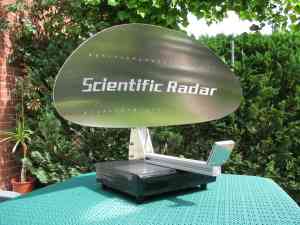Didactional Multifunction Radar DMR “Scientific Radar”
Description of the radar set, tactical-technical characteristics

Figure 1: Scientific Radar - Didactional multi-function radar, K-Band- version

| Specifications | |
|---|---|
| frequency: | S, C oder K-Band |
| average power: | 4 mW |
| instrumented range: | > 20 m |
| range resolution: | |
| accuracy: | |
| beamwidth: | |
| MTBCF: | |
| MTTR: | |
Didactional Multifunction Radar DMR “Scientific Radar”
The Didactional Multifunction Radar DMR is constructed as a special didactical radar for vocational training, specially adapted to the particular client requirement and the desired training topics. Practically every device is unique because it is built from a wide variety of modular sub-devices, adapted to the requirements of the training topics. It operates as desired in the frequency range S-Band, C-Band and X-Band, some features may be extended to the K-Band. For the construction will be partly used original radar modules made by leading manufacturers, as well as lower-priced standard commercial components for communications technology.
The following modes as LPI radar (low probability of intercept radar) may be selected:
- Pulsed radar (intrapulse modulated, as well as classic short keyed on/off pulses), shortest pulse: 25 ns, longest pulse … yeah … up to CW- or FMCW-Radar;
- pure unmodulated CW radar (however, this is only useful with a stationary antenna)
- following modes as
FMCW radar are possible:
- FMCW-Radar with classic sawtooth- or triangle shaped frequency shift (Chirp-radar);
- FSK-FMCW (frequency shift keying FMCW);
- SFMCW (stepped frequency modulated CW) for interferometric measurements;
- FMiCW (Interrupted FMCW) for better isolation between transmitter and receiver
- PMCW (phase modulated CW) with pseudorandom codes.
Core of this radar is a freely programmable synthesizer for the transmit signal, which is based on a fast microprocessor. With a clock speed of 40 MHz, it has a temporal resolution of a minimum of 25 nanoseconds and an accuracy in the range of less than 4 nanoseconds. Using this module, all necessary for the operation of radar trigger pulses and switching gate signals are provided. The good temporal resolution and free programming option also allows direct control of a phase modulator. At the same time can be provided two analog control voltages in any form with the same resolution and accuracy and a maximum cycle time of more than 8 milliseconds. These can control either a voltage controlled oscillator (VCO) for an FMCW radar, or may be used directly as input voltages (sine and cosine) for the modulator of an intra-pulse modulated pulse radar. It can be designed practically arbitrary radars with this programmable synthesizer.
But for mechanical reasons and resulting physical laws, this radar is not suitable to represent a target tracking radar. Also an use as SAR is not possible. Only at a later stage of development of software, it would be possible to implement an ISAR function, whose hardware-related conditions are already given.
Each device is supplied with a customized training material. This home page provides a little insight for its quality and scope here. Prepared training materials provide students to develop a practice in many areas in radar technology based on devision of own experiences. Likewise, the teacher has access to a variety of good graphics and animations for his seminars, which are confirmed by practical measurements.